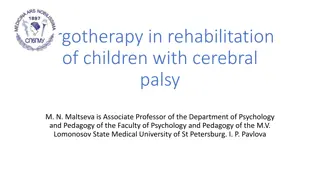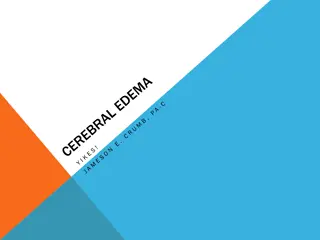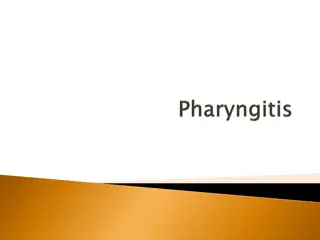
Chronic Neurological Infections and Meningitis: Symptoms, Causes, and Diagnosis
Explore the signs, symptoms, and potential causes of chronic neurological infections and meningitis, including bacterial and viral origins. Learn about common diseases like tuberculosis, brucellosis, and possible differentiation methods. Discover the importance of prompt diagnosis and treatment for these conditions.
Download Presentation

Please find below an Image/Link to download the presentation.
The content on the website is provided AS IS for your information and personal use only. It may not be sold, licensed, or shared on other websites without obtaining consent from the author. If you encounter any issues during the download, it is possible that the publisher has removed the file from their server.
You are allowed to download the files provided on this website for personal or commercial use, subject to the condition that they are used lawfully. All files are the property of their respective owners.
The content on the website is provided AS IS for your information and personal use only. It may not be sold, licensed, or shared on other websites without obtaining consent from the author.
E N D
Presentation Transcript
SYMPTOM SIGN +/-Papilloedema Brud Zinc or Kerning 'positive sign of meningeal irritation Chronic head ache Neck or back pain Change in personality Altered mental status, memory loss, etc Seventh nerve palsy Facial weakness 3,4,6 th,Nerve palsy Double vision ,visual loss Ataxia Arm and leg weakness Hydrocephalus clumsiness
A Bacterial, Most important a)Tuberculosis in Saudi Arabia b)Brucellosis c) Partially treated acute meningitis d) Syphilis-caused by Treponema Pallidium E) Liptosporosis- caused by L.Icter haemorraghia F) Lyme disease-caused by Borrelia burgdorferi not common in Saudi Arabia g)Nocardiosis-caused by Nocardia speciese.g N.Asteroids h) Cerebral abscesses can also same -----preferred as chronic infection
a- Cryptococcus neoformans b-Candida species in Saudi Arabia species mainly Candida albicans in immunocompromised patients c- Aspergillus species d- Histoplasma capsulatum
a- Toxoplasma gonodii(most common) b- Trypanosoiasis:caused by T.gambiense T. c- Rare causes Acanthamoeba spp
Some virus can some present as chronic meningitis these include: a- Mumps b-Herpes simplex c- HIV
1- Tuberculosis 2- Brucellosis They should differentiated on the basis of: a- Clinical History b- Occupations c- Clinical symptoms d- Clinical signs in other organism e- Cerebrospinal fluid findings
Is common disease in Saudi Arabia It affect people who are in contact with domestic animals or those who consume raw milk and milk products It usually presents with Pyrexia( fever) of unknown organism of intermittent nature The fever is accompanied by night sweating, in between the attacks of fever the patient is not very ill. Same reasons it can caused chronic cerebral infection and meningitis The commonest causes in Saudi Arabia is Br.melitensis
Is caused by Mycobacterium tuberculosis Which infect one third of human race The patient usually presents with fever of long duration Symptoms of cough and coughing of blood (Haemoptoysis) when the chest is affected It some cases present as meningitis and cerebral infection presenting chronic neurological symptoms and signs
a) Neurological disability and, may be b) Fatal if not treated They usually have:- a) Slow insidious on set b) with progression of signs and symptoms over a period of weeks They differ from those of acute infection which have a) Rapid on set of symptoms and signs They are usually diagnosed ,if the neurological syndrome exists for > 4 weeks
a- History as mentioned for Brucellosis and Tuberculosis if b-Clinical examination c- Imaging by x- ray or MRI or ultrasound d- Laboratory findings
This is mainly related to the laboratory examination of cerebrospinal fluid including:- a-Collect of 2-5 ml of CSF and checking for the pressure b- Bio chemical investigation for : 1- Total protein 2- Glucose level in comparison to the serum glucose level c- Microscopy: 1- Presence of organism 2- Total white cell count 3- Differential count mainly for:- a- Polymorphic b- Lymphocytes
a- Increased CSF pressure indicating increased intra cranial pressure b- Increased protein level due to presence of inflammatory substance, dead organism, protein and WBC c- Reduced glucose level ( Normally is 2/3 of serum glucose level) d- Increased local white cell count but in chronic infection the differential shows lymphocytosis while in acute infections there is increased % of polymorph e- Gram stain can same time rarely shows causative organism f- Z-N Stain can show AFB of T.B while modified Z-N can show Nocardia
g- VDRL and other serological causes for syphilis h- Wet preparation of CSF for fungal and parasite i- India ink for Cryptococcus neoforman j- Culture for CSF for Brucella,T.B Mycobacterium tuberculosis, Leplospira other Bacteria
a) Mantoux test, Tuberculin skin test(TST) b)Chest x-ray for primary focus c) CSF microscopy for AFB d) CSF culture an solid medium L.J or fluid medium e) PCR or other molecular biopsy test for presence of bacterial element f) Culture of CSF for Brucella g) Serology for Brucella Combination of these finding with clinical history and examination finding
Tuberculosis 4 Drugs are used there are:- 1- Rifampicin 2- Isonized(INH) for 2 month 3- Ethambutol 4-Pyrazinamide Then, Rifampicin for 4-6 month INH
Two of the following 3 drugs a- Tetracycline b- Rifampicin c- Cotrimoxazole Usually Rifampicin and Cotrimoxazole are preferred as they have good penetration power in the blood brain- barner






















